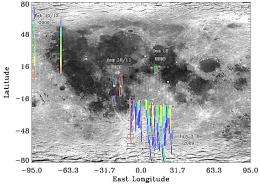C1XS success will provide new understanding of lunar surface

Over its ten months of operation, the Chandrayaan-1 X-ray Spectrometer (C1XS) gathered data for a total of 30 solar flares, giving the most accurate measurements to date of magnesium, aluminium, silicon, calcium and iron in the lunar surface. Results will be presented at the European Planetary Science Congress in Potsdam, Germany, by the instrument’s Principal Investigator, Professor Manuel Grande on Friday 18 September.
Although contact was lost with Chandrayaan-1 last month, the enhanced performance of the C1XS instrument, which exceeded its design specification, means that the science team will be able to determine the geochemistry of several key new areas of the lunar surface, adding some vital pieces to the jigsaw of the mineralogy of the lunar surface.
The miniature C1XS instrument investigated the lunar surface using an effect whereby X-ray illumination from the Sun causes rocks to fluoresce, emitting light at a different wavelength. This re-emitted light contains spectral peaks that are characteristic of elements contained in the rock, revealing its composition. Solar flares act like a flash bulb, giving added illumination and allowing C1XS to ‘see’ more elements.
During normal conditions, C1XS could detect magnesium, aluminium and silicon and collected data on the levels of these elements enabling detailed mapping of areas of the lunar surface during its operational period. During the 30 solar flares, C1XS detected calcium and iron (and sometimes titanium, sodium and potassium) in key areas in the southern hemisphere and on the far side of the Moon. The spectral resolution of 50 km was much better than previous missions.
“The C1XS team will be analysing the data collected during the Chandrayaan-1 mission over the next few months and the results will help us further our knowledge of the Moon and planetary formation. In addition, the design of the instrument has been proved very successful in that it withstood passage through the Earth’s radiation belts and went on to produce these wonderful high-resolution spectra. We were able to separate clear peaks for each of the target elements, allowing us not only to identify where they are present but give an accurate estimate for how much is there. The technology developed for C1XS opens up some exciting opportunities for future missions,” said Professor Grande.
Provided by European Planetary Science Congress




















